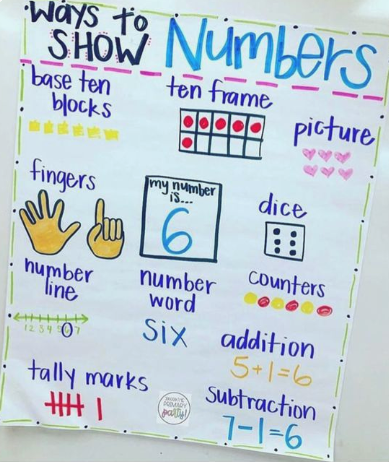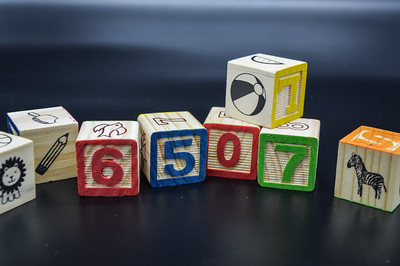Summary
Students will build, read, and write numbers to 100 using a myriad of math manipulatives. In this lesson, students will learn there are different ways to create the same number.
Essential Question(s)
Is there more than one way to represent a number?
Snapshot
Engage
Students listen to the song "I Can Show Numbers in So Many Ways" by Jack Hartmann and then create a list or chart of the different ways to show numbers.
Explore
Students enjoy building and writing two-digit numbers using dice as they participate in a Scoot activity.
Explain
As a class, students create an Anchor Chart listing the six specific ways of building and writing a number.
Extend
Students scoop beans or beads and estimate the number. Then, they write and build numbers with a variety of math manipulatives.
Evaluate
Students are assessed in small groups, with the teacher choosing a number appropriate for each student to read, build, and complete a Frayer Model format.
Materials
"I Can Show Numbers in So Many Ways" song
Digit Number Generator (link included)
Building Numbers Frayer handout (attached; one per student)
Chart paper
Dice
Base 10 blocks (rods and units)
Small whiteboards and d
ry erase markers
Penny and dime manipulatives
Ten Frames
Two-sided counters, b
eads or beans
Small measuring cups
Buckets or gallon-sized bags for beads
Engage
20 Minute(s)
On the carpet, ask students, "Is there more than one way to represent a number?" Explain that "represent" can mean to write, build, draw, etc. Allow different students to answer "yes" or "no" and give examples. Invite students to share other ways during this time. Once several students have responded, have them listen and watch the song "I Can Show Numbers in so Many Ways" by Jack Hartmann.
Next, have the students turn and talk to a partner about the different ways they saw numbers represented. After a minute or two of discussion, have a class-wide brainstorming session on the different ways they saw numbers represented, and have them write their examples on a piece of chart paper. The video shows Numeral, 5-frame, 10-frame, tallies, number-line, words, pictures, dice, domino, and finger.
One way to organize the students' responses is to build a class Anchor Chart. Here is one example:

After they have listed the different ways that numbers were represented in the song, ask the students if they have ever seen numbers represented in a way that was not in the song. Include these examples on the Anchor Chart. Possible responses might include beads, sticks, adding two numbers together, money, bears, counters, linking cubes, number sentences, and drawings.
At the end of the lesson, replay the song and encourage students to dance and sing to the music.
Explore
30 Minute(s)
At the beginning of the Explore phase, have students work through a Scoot activity. Model each table’s activity before starting the Scoot. After modeling each task, number students 1-5 and have them go to the table that matches their assigned number. Give students 5 minutes to complete their number task at the table, then ring the bell (or transition you have in your room) to "scoot" to the following table.
Here are the Scoot activities:
Table 1: Students roll two dice to create a two-digit number, then build that number with pennies and dimes.
Table 2: Students roll two dice to create a two-digit number, then write tally marks on a dry erase board to represent that number.
Table 3: Students roll two dice to create a two-digit number, then use base ten blocks to build that number.
Table 4: Students roll two dice to create a two-digit number, then build the number with 2-sided counters on laminated double ten frames.
Table 5: Students roll two dice to create a two-digit number, then use beads (or beans) to build the number (sorting into 10’s and 1’s).
Explain
20 Minute(s)
Back on the carpet, talk about what happened during the Scoot activity. Have them consider the activity: What did they do? In what different ways were the numbers represented?
As a class, create another Anchor Chart that shows just six different ways to represent a number. First, write the number in numeral and word form in the middle of the paper. Then in each corner, invite students to represent that number differently using base-ten form, expanded form, tally marks, and ten frames.
Use the two-digit number generator to generate the numbers.
As you continue to generate numbers, have students record on individual dry erase boards the different ways they have learned. Ask them to check their work with an Elbow Partner.
Extend
20 Minute(s)
Have students take one turn scooping their beads and carefully pouring them out in front of them to be sorted into 10s and 1s.
Before counting, have students estimate how many beads they have scooped and write their estimate on their recording sheet. After estimating, have students sort into groups of 10s and the leftover 1s, then record that number on their sheet in numeral form, base 10 form, expanded form, and tally marks.
*Please note that Anchor Charts displaying each of these different number representations can be hung in the room during this stage of learning. Another way of having it modeled is to create a small Frayer Model and place it at each table for students to reference.
Evaluate
10 Minute(s)
Assess students in small groups at the teacher table by choosing a number for students to read, then build and write in a Frayer Model format. Have manipulatives ready for students who still need to make a concrete model before drawing it on their paper.
Replay the song and encourage students to dance and sing to the music.
Opportunities for Advanced Learners
Once students have mastered building the numbers with manipulatives, have them make the same number with the same manipulative differently. For example, "I see you have built the number 53 with 5 rods and three units. While that is correct, how might you build that same number differently using base ten blocks?" For example, show students that 53 could be built with 4 rods and 13 units.
"Can you build the same number in different ways with other manipulatives? For example, what is another way to build 53 with dimes and pennies?"
When students understand the concept of using a variety of manipulatives to achieve the same answer, they can solve the problem in different ways and connect back to addition. For example, "Yes, 4 rods and 13 units equals 53. If I wrote that in a number sentence, it would be 40+13=53."
Resources
Eduprints Plus. (2018, 23 October). "Numeracy for children— Educational toys— Wooden number blocks." https://www.flickr.com/photos/144975701@N08/45573260342
Jack Hartmann Kids Music Channel. (2017, 29 October). I can show numbers in so many ways. Video. [YouTube]. https://www.youtube.com/watch?v=lAQ2HTqTl2w
K20 Center. (n.d.). Anchor charts. Strategies. https://learn.k20center.ou.edu/strategy/58
K20 Center (n.d.) Elbow partners. Strategies. https://learn.k20center.ou.edu/strategy/116
K20 Center. (n.d.). Scoot. Strategies. https://learn.k20center.ou.edu/strategy/2298
K20 Center. (n.d.) Frayer model. Strategies. https://learn.k20center.ou.edu/strategy/126
Number Generator.org. (n.d.). Number generator. https://numbergenerator.org/randomnumbergenerator/1-100
Planchon, Heather. (2020, Aug 24). The Primary Party. Ways to show number anchor chart. https://www.pinterest.com/pin/179369997647259148/


